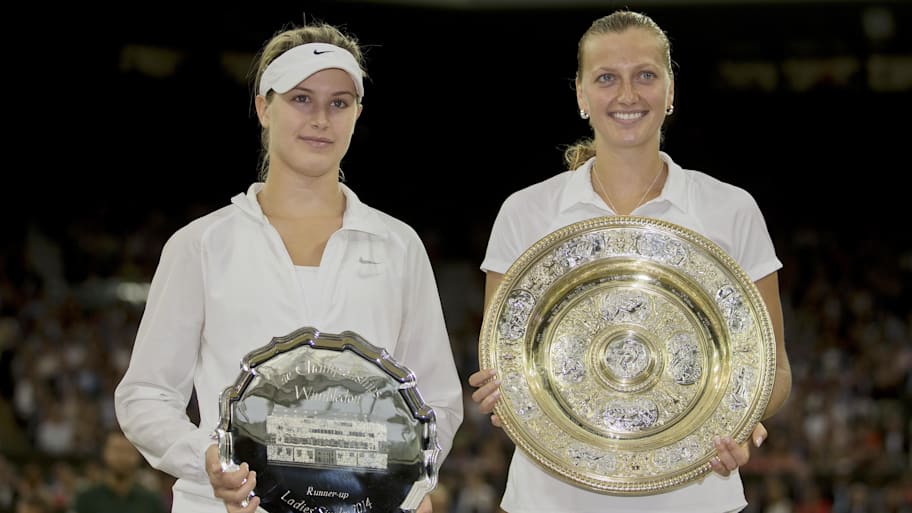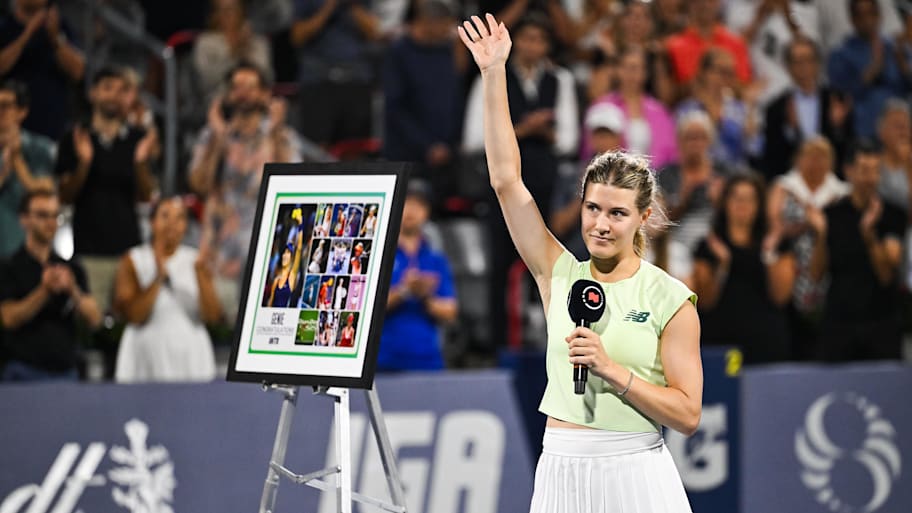Hey everyone …
• Here’s this week’s Served podcast with special guests, Bob and Mike Bryan, in advance of their Hall of Fame induction.
We’ll have some details soon about live shows and the U.S. Open draw edition on the site itself.
• Here’s a lovely write-up of Served, thanks to Reem Abulleil.
• Congrats Ross Hutchins, the new CEO of the ITF.
• To last week’s discussion about GOAT metrics, we all owe a debt to reader Keegan Greenier, whose excellent table is included at the bottom of the column.
Onward …
We had several questions about Eugenie Bouchard, who announced her retirement the other night in Montreal. With the National Bank Open/Canadian Open/Canada Masters 1000 still underway, let’s start here (and save talk of Victoria Mboko, etc., for next week). Some scattered thoughts on Bouchard:
A) She had a towering career that included a Wimbledon final, top-five ranking, titles and wins. Stand back, and this is a top-shelf career. Add in her role as an engine for Canadian tennis, and all the plaudits last week were well-deserved.
B) Her run in Canada encapsulates why it is so difficult for athletes to decide when to retire. In some ways, it was the perfect context: hometown kid made good and all. She went out in a competitive last match against Belinda Bencic, a top player. Yet, in other ways, surely she must have been thinking, Wait, I’m outside the top 500 but I’m up a break in the third set against an opponent who played in the Wimbledon semifinal a few weeks ago. Remind me, why am I retiring?
C) Timing matters. Arcs matter. I’m going to pick a name at random here … Marie Bouzková. You can have a fine career like Bouzková, winning the occasional title and bobbing around the No. 25 to 60 range. Play some doubles and make $1 million or so a year. Life is good. The problem is that when you have reached a major final in your early 20s, made eight figures in endorsements, and been in the top five, the career of Bouzková is a lot less fun. Bouchard, in some respects, was a victim of her success. After that Wimbledon final, Bouchard barely won half the matches she played at majors. Her ranking dropped to the point where she had to qualify.
D) I had the chance to work with Bouchard at Tennis Channel. She was among the coolest and most collegial players we’ve had. She didn’t just show up and start free associating; she carried a notebook and prepared for each show. She took direction. She arrived early and stayed late. This attitude was reflected in her tennis.
E) A proper accounting of Bouchard must reference the lawsuit she filed—and settled, very much in her favor—against the USTA. What does her career look like if (while coached by Jimmy Connors) she doesn’t suffer that slip and fall?
F) It will be interesting to see what she does next. She’s pickleballing at the moment, but still has options in tennis. She’s Canadian but has options in the U.S. She’s extroverted. She has a whopping (and valuable) social media presence. She’s only 31 and has lots of runway ahead.

Hey Jon,
I've listened to and read your concerns about the tennis schedule and on a recent Served, you and Andy seemed bothered by the presence of too many tournaments on the schedule and “stars” backing out of tournaments due to fatigue and the need to recover. I honestly don't understand the real problem. If a player needs rest, by all means, take a break. Opening up some tournament spots for players further down the rankings to get exposure, experience, ranking points and prize money seems perfectly fine to me. As long as fan interest is there and the tournaments are financially stable, where does the problem lie? Would it really be better to have fewer tournaments to ensure that all the “stars” are present at them? Is it truly a zero sum situation?
Thanks, Dan
Kalamazoo, MI
• You ask fair questions, and fundamental ones. What is the right number of tournaments? How much do stars matter? For that matter, what is the right number of people that should be able to make a living as a professional tennis player?
A few points:
A) The attitude of the tournament —and by extension the tours—is not “If a player needs rest, by all means, take a break.” It is: We have put up millions of dollars in prize money and sanctioning fees, and we expect the stars. Through carrots (bonuses) and sticks (fines), they are expected to play. Remember, these are even called “mandatory.”
B) You’re right that the market will decide. Will fans and sponsors buy tickets to an event featuring fewer than half the top 10 ATP players and neither the ATP nor WTA No.1? Will Masters 1000 events offer this prize money—and increase it by 7% year-over-year—for a lesser field? But there’s a macro question: What is the best model for the sport overall?
C) Is there no value in scarcity? As the NFL or Formula One can attest, there could be a race each week or, in the case of football, a longer season, but that would diminish the product. The novelty would wear off. And the most successful leagues have discovered that restricting supply increases demand.
D) What is the cost of these sprawling Masters 1000 events? The players hate them. The top players are disincentivized to enter and spend days upon days away from training bases, in hotel rooms, feeling dislocated and annoyed. The fans are, at best, indifferent. Small tournaments are crowded out and majors feel that their product is being diminished when other tournaments are nearly as long—still more encouragement for them to turn into three-week events and regain competitive advantage.
Jon, not sure if you have been following TennisCentel. It seemed like Holger Rune complained and got it shut down. But now it might be back in operation. But I wondered if you had thoughts about this account?
Bo Nanza
• First, great handle by you. Second, let’s—as they say on Zoom calls—level-set: TennisCentel is/was a parody account that, like other Centels, traffics in “alternative facts.” Best I can tell: Rune complained about the account last week. It went dark. Now it is back. Sometimes I laugh along with TennisCentel. Other times, I think it crosses a line. Yay, parody. Boo, gratuitous meanness. Then there is the issue of misinformation and disinformation.
To me, this account provides a fascinating glimpse into memory and the way we all process information. Often, fans and commentators repeat one of the TennisCentel bits, conflating fiction with fact. The easy take goes like this: Look how lazy and gullible commentator XYZ is!
The more complicated take: We are all scrolling all day. A million bits of flotsam and jetsam are flitting past our eyes and worming into our brains. It’s not absurd that we process a bit of nonsense. Daniil Medvedev vows never to play clay again! And then a few days later, when Medvedev’s name comes up, the commentator kinda sorta vaguely recalls this factoid, without remembering that it first came to them in parody form.
This is the long-haul danger of fake news. Yes, it’s the initial blast of unverified and false information, but it’s also that the bloodstream is contaminated. Days or weeks later, we recall hearing something, and we can no longer parse whether or not it was accurate.
Jon, You mentioned in the last mailbag about Grand Slam count and legacies and the number of Australian Open’s Chris Evert played, however what stands out to me more is her not playing the French Open between 1976–78. She had won the title the two years before and after and was so dominant on clay. Was it events here in the U.S. that led her to skip? You have to think this could have added three more slams to her title.
Bob Richter, Green Bay
• Random observation: It’s remarkable how often Chris Evert—who hasn’t played a major since 1989—figures into the questions we get. Let’s go to the source. Why did she miss those three French Opens in the prime of her career? From the great herself: “World team tennis! Couldn’t play the French, [Darnitt]!!!”
Let’s go ahead and give her credit for those three titles. We’ll give Martina Navratilova another three, maybe for all those Australian Opens she missed. That brings the major head-to-head to 21–21 for those scoring at home.
I’m sure mixed doubles this year will have a huge audience. I certainly plan to watch. However, as it's been turned into an entertainment only—expect no serious tennis—event, I have one suggestion.
Make the $1 million prize a donation to the charity(ies) of the winning team’s choosing. Certainly the megastars now playing this event have no need for the prize money.
Michelle Ippolito
Fernley, Nev. 89408
• I like the zip code touch. And I like your thinking, but I wouldn’t generalize quite too broadly. For instance, Andrea Vavassori, who won last year’s U.S. Open mixed title with Sara Errani, is 30 years old and has won less than $3 million for his entire career. A title would represent a career earning boost of almost 20%. Let him keep his money.
Likewise, Olga Danilović is currently under $2.5 million in career earnings. (Her doubles partner, on the other hand, Novak Djokovic, is closing in on $190 million career earnings, so he might be more inclined toward philanthropy.)
Dear Jon,
Years ago I wrote and you published a few short paragraphs extolling the virtues and pleasures of the Montreal tennis tournament, and I’m writing now to repeat my endorsement. Although it’s a full bore Masters 1000 tournament I imagine it pales somewhat in comparison to Indian Wells and some of the others, but in my mind it makes up in charm whatever it may lack in grandiosity. It has great access to practice courts where I enjoyed watching [Coco] Gauff & [Anastasia] Pavlyuchenkova, [Mirra] Andreeva & [Jasmine] Paolini, and [Emma] Navarro & [Iga] Świątek hitting with each other, as well as [Naomi] Osaka and [Jessica] Pegula working with their coaches. After her practice I watched Andreeva walk from her court to the players’ lounge surrounded by a cloud of tween and teen girls. They seemed to be enjoying each other and she looked less like a world famous, globe-trotting tennis star than a counselor at a summer camp ferrying her charges to the mess hall. Especially in these fraught political times it was so nice to go north of the border and enjoy the fellowship of the ever friendly and happy Canadians, plus it’s all in French.
Roger Jones
• I love it. I imagine Andreeva would make for an outstanding camp counselor. We already know about her arts and crafts skills. As for your main point, I would add that Montreal is one of the gem cities of North America.
Shots
• British journalist Mark Hodgkinson has a new Carlos Alcaraz book out next week. You can pre-order it here.
• Take it away, Keegan Greenier …

More Tennis on Sports Illustrated
This article was originally published on www.si.com as Tennis Mailbag: Eugenie Bouchard’s Retirement Puts Career in Perspective.
